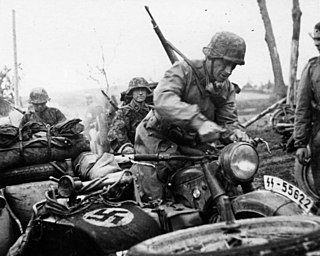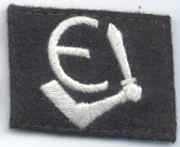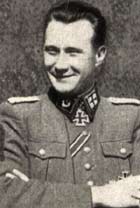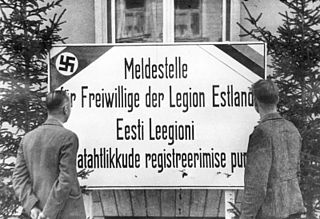
The Waffen-SS was the combat branch of the Nazi Party's paramilitary Schutzstaffel (SS) organisation. Its formations included men from Nazi Germany, along with volunteers and conscripts from both occupied and unoccupied lands.

The Waffen Grenadier Brigade of the SS Charlemagne was a Waffen-SS unit formed in September 1944 from French collaborationists, many of whom were already serving in various other German units. Named after the 9th-century Frankish emperor, it superseded the existing Legion of French Volunteers Against Bolshevism formed in 1941 within the German Army (Wehrmacht) and the SS-Volunteer Sturmbrigade France formed in July 1943, both of which were disbanded the same month. The division also included French recruits from other German military and paramilitary formations and Miliciens who had fled ahead of the Allied Liberation of France.

The Flemish Legion was a collaborationist military formation recruited among Dutch-speaking volunteers from German-occupied Belgium, notably from Flanders, during World War II. It was formed in the aftermath of the German invasion of the Soviet Union and fought on the Eastern Front in the Waffen SS alongside similar formations from other parts of German-occupied Western Europe.
The III (Germanic) SS Panzer Corps was a Waffen-SS armoured corps which saw action on the Eastern Front during World War II. The (Germanische) part of its designation was granted as it was composed primarily of foreign volunteer formations.

The Battle of Narva Bridgehead was the campaign that stalled the Soviet Estonian operation in the surroundings of the town of Narva for six months. It was the first phase of the Battle of Narva campaign fought at the Eastern Front during World War II, the second phase being the Battle of Tannenberg Line.

The Battle of Narva was a World War II military campaign, lasting from 2 February to 10 August 1944, in which the German Army Detachment "Narwa" and the Soviet Leningrad Front fought for possession of the strategically important Narva Isthmus.

The Battle of Tannenberg Line or the Battle of the Blue Hills was a military engagement between the German Army Detachment Narwa and the Soviet Leningrad Front. They fought for the strategically important Narva Isthmus from 25 July–10 August 1944. The battle was fought on the Eastern Front during World War II. The strategic aim of the Soviet Estonian Operation was to reoccupy Estonia as a favorable base for the invasions of Finland and East Prussia. Waffen-SS forces included 24 volunteer infantry battalions from the SS Division Nordland, the SS Division Langemarck, the SS Division Nederland, and the Walloon Legion. Roughly half of the infantry consisted of the personnel of the 20th Waffen Grenadier Division of the SS. The German force of 22,250 men held off 136,830 Soviet troops. As the Soviet forces were constantly reinforced, their overall casualties are estimated by Estonian historian Mart Laar to be 170,000 dead and wounded.

The Volunteer Legion Netherlands was a collaborationist military formation recruited in the German-occupied Netherlands during World War II. It was formed in the aftermath of the German invasion of the Soviet Union and fought on the Eastern Front in the Waffen SS alongside similar formations from other parts of German-occupied Western Europe. It was the largest Dutch SS unit.

The 20th Waffen Grenadier Division of the SS was a foreign infantry division of the Waffen-SS that served alongside but was never formally part of the Wehrmacht during World War II. According to some sources, the division was under Reichsführer-SS Heinrich Himmler's overall command but was not an integral part of the Schutzstaffel (SS). It was officially activated on 24 January 1944, and many of its soldiers had been members of the Estonian Legion and/or the 3rd Estonian SS Volunteer Brigade, which had been fighting as part of German forces since August 1942 and October 1943 respectively. Both of the preceding formations drew their personnel from German-occupied Estonia. Shortly after its official activation, widespread conscription within Estonia was announced by the German occupying authorities. The division was formed in Estonia around a cadre comprising the 3rd Estonian SS Volunteer Brigade, and was initially known as the 20th Estonian SS Volunteer Division.

During World War II, in the course of Operation Barbarossa, Nazi Germany invaded Estonia in July–December 1941, and occupied the country until 1944. Estonia had gained independence in 1918 from the then warring German and Russian Empires. However, in the wake of the August 1939 Nazi-Soviet Pact, the Stalinist Soviet Union had invaded and occupied Estonia in June 1940, and the country was formally annexed into the USSR in August 1940.

The 29th Waffen Grenadier Division of the SS also Legione SS Italiana was an SS formation of Nazi Germany during World War II. It was originally created in the puppet Italian Social Republic in 1943 as the Italian Legion, later renamed to a brigade. The unit was upgraded to division status on 10 February 1945.

Harald Riipalu was an Estonian commander in the German Wehrmacht and the Waffen-SS during World War II. He was a recipient of the Knight's Cross of the Iron Cross of Nazi Germany.

The Estonian Legion was a military unit within the Combat Support Forces of the Waffen-SS during World War II, mainly consisting of Estonian soldiers.

Harald Nugiseks was an Waffen-Oberscharführer (Sergeant) in World War II, who served in the 20th Waffen Grenadier Division of the SS of the Waffen-SS. Nugiseks is also one of the four Estonian soldiers who received the Knight's Cross of the Iron Cross.
The 2nd SS Infantry Brigade (mot.) was formed on the 15 May 1941, under the command of Karl Fischer von Treuenfeld with the 4th and 5th SS Infantry Regiments and began its operational service in September in the Army Group North Rear Area, under which command it would spend its entire existence. It gradually began to incorporate foreign legions of the SS under its operational control. After the western legions departed for refit, it began operating with Latvian volunteer formations and eventually was redesignated the 2nd Latvian SS Infantry Brigade and on the 18 May 1943, and used as the cadre in the formation of the Waffen Grenadier Division of the SS in January 1944.

During World War II, the Waffen-SS recruited significant numbers of non-Germans, both as volunteers and conscripts. In total some 500,000 non-Germans and ethnic Germans from outside Germany, mostly from German-occupied Europe, were recruited between 1940 and 1945. The units were under the control of the SS Führungshauptamt beneath Reichsführer-SS Heinrich Himmler. Upon mobilization, the units' tactical control was given to the Oberkommando der Wehrmacht.
Estonian Auxiliary Police were Estonian collaborationist police units during World War II.

This is a sub-article to Battle of Narva (1944).
Edgar Joseph Alexandre Puaud was a French army officer, who, in 1945, briefly became commander of the Charlemagne Division, a French unit of the Waffen-SS in the service of Nazi Germany.















